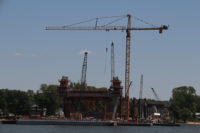The institutional building group year-to-date was down 2%, with the two largest institutional categories performing as follows—educational buildings, unchanged from the previous year; and health care facilities, down 4%. The smaller institutional categories showed this year-to-date pattern—amusement-related projects, up 24%; transportation terminals, up 5%; religious buildings, down 8%; and public buildings, down 23%.
Nonbuilding Construction
Nonbuilding construction, at $127.1 billion (annual rate), dropped 21% in November. The public works portion of nonbuilding construction fell 23%, with the largest decline registered by bridge construction, down 73%. The bridge category in October had been boosted by $2.8 billion for the start of structural work on the Tappan Zee Bridge replacement project across the Hudson River in the Tarrytown, N.Y., area. In November, the largest bridge project reported as a construction start was a $125-million bridge reconstruction in Fall River, Mass.
Additional public works categories with November declines were highway construction, down 3%; and sewers, down 32%. On the plus side, both river/harbor development and water supply construction showed improvement from a lackluster October, advancing 47% and 3% respectively.
The miscellaneous public works category, which includes such diverse project types as pipelines and mass transit, grew 8% in November with the help of the $300-million Keystone Pipeline Gulf Coast Expansion in Texas. Electric utility construction in November edged up 1%, staying basically unchanged from its sharply reduced amount in October. The largest electric utility project reported as a November start was a $400-million wind farm in the state of Washington.
For the January-November period of 2013, nonbuilding construction was down 15% from a year ago. After reaching a record high in current dollar terms back in 2012, the volume of new electric utility starts has fallen sharply in 2013, plunging 59% year-to-date. Running counter has been the public works sector, posting year-to-date growth at 5%. The largest increase was registered by bridge construction, up 41%, reflecting the start of several very large bridge projects over the course of 2013.
The substantial year-to-date gain for bridge construction was accompanied by a 9% increase for highway construction. For environmental public works, year-to-date growth was reported for river/harbor development, up 25%; and water supply construction, up 10%; while sewer construction was unchanged from its 2012 amount. The miscellaneous public works category dropped 20% year-to-date, as the dollar amount of pipeline projects retreated from the strong pace witnessed during 2012.
Residential Building
Residential building in November improved 1% to $218.5 billion (annual rate). The upward push came from the multifamily side of the housing market, which climbed 18%. Large multifamily projects reported as November starts included a $450-million multifamily tower and the $126-million condominium portion of a $300-million condo hotel, both located in New York City.
Also reaching groundbreaking in November were a $114-million multifamily tower in San Francisco, a $100-million apartment complex in Huntington Station, N.Y., and a $100-million multifamily tower in Chicago. Single-family housing in November receded 3%, pulling back after a 4% gain in October. The November pace for single-family housing was still 12% above what was reported at the outset of 2013.
During the first 11 months of 2013, residential building advanced 25% compared to a year ago. Single-family housing will come close to matching last year’s strong percentage gain (up 29%), reporting a 27% increase in this year’s January-November period.
By major region, single-family housing showed this year-to-date performance—the South Atlantic, up 35%; the Midwest, up 29%; the West and Northeast, each up 26%; and the South Central, up 19%.
Multifamily housing year-to-date climbed 21%, a strong rate of increase although revealing some deceleration from the sharp rise (up 37%) reported for the full year 2012. By major region, multifamily housing showed this year-to-date performance—the Northeast, up 43%; the Midwest, up 26%; the South Atlantic, up 22%; the West, up 11%; and the South Central, down 6%. The top five metropolitan areas in terms of the dollar amount of multifamily starts year-to-date were: New York City, up 47%; Boston, up 87%; Washington, D.C., up 9%; Miami, up 5%; and Los Angeles, down 24%.
The 6% increase for total construction starts at the national level during the first 11 months of 2013 was supported by gains in three of the five major regions. Leading the way was the Northeast, up 21%; followed by the Midwest, up 11%; and the West, up 9%. Total construction starts in the South Central region were unchanged year-to-date, while the South Atlantic showed a 3% decline.
The South Atlantic shortfall reflected the comparison to the first 11 months of 2012 that included the start of two massive nuclear facilities. If electric utilities are removed from the year-to-date construction statistics in the South Atlantic, then total construction for that region in 2013 would be up 21%.



Post a comment to this article
Report Abusive Comment